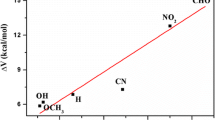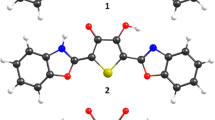Abstract
Excitation energy transfer along molecular wires depends on the orientation of the transition dipole moments of the neighboring chromophores. This transition dipole moment is changed upon the proton transfer in the studied compounds. To this end, a quantum chemical characterization of 6-phenyl-2-thioxo-1,2-dihydropyridine-3-carbonitrile (2-mercapto-6-phenylpyridine-3carbonitrile) compound and its derivatives is performed using Density Functional Theory. The effect of the substitutions in the parent compound on the energy barrier between thiol and thione intraconversion as well as on the transition dipole moment was studied. The Intra-proton transfer (IMPT) process based on intrinsic reaction coordinate IRC calculations was energetically more favorable in the excited state (S1) than the ground state (S0) for all studied compounds. The effect of different substituents on the transition dipole moment orientation between thiol and thione was calculated. It was found that the electron withdrawing groups lead to high change in the transition dipole moment orientation through thiol/thione intra-conversion. The excited state energy transfer can be controlled by 20–100% depending on the orientation factor through the IMPT.









Similar content being viewed by others
References
Rashad AE, Hegab MI, Abdel-Megeid RE, Abdel-Megeid MJA, FM, (2008) Synthesis and antiviral evaluation of some new pyrazole and fused pyrazolopyrimidine derivatives. Bioorg Med Chem 16:7102–7106
Shaheen F, Badshah A, Gielen M, Gieck C, Jamil M, de Vos D (2008) Synthesis, characterization, in vitro cytotoxicity and anti-inflammatory activity of palladium (II) complexes with tertiary phosphines and heterocyclic thiolates: Crystal structure of [PdC28H19N8PS2]. J Organomet Chem 693(6):1117–1126
Son JK, Zhao LX, Basnet A, Thapa P, Karki R, Na Y, Lee ES (2008) Synthesis of 2, 6-diaryl-substituted pyridines and their antitumor activities. Eur J Med Chem 43:675–682
Zhao LX, Sherchan J, Park JK, Jahng Y, Jeong BS, Jeong TC, Lee ES (2006) Synthesis, cytotoxicity and structure-activity relationship study of terpyridines. Arch Pharmacal Res 29:1091–1095
Basnet A, Thapa P, Karki R, Na Y, Jahng Y, Jeong BS, Lee ES (2007) 2, 4, 6-Trisubstituted pyridines: synthesis, topoisomerase I and II inhibitory activity, cytotoxicity, and structure–activity relationship. Bioorg Med Chem 15:4351–4359
Cesarini S, Spallarossa A, Ranise A, Schenone S, Rosano C, La Colla P, Loddo R (2009) N-Acylated and N, N′-diacylated imidazolidine-2-thione derivatives and N, N′-diacylated tetrahydropyrimidine-2 (1H)-thione analogues: Synthesis and antiproliferative activity. Eur J Med Chem 44:1106–1118
Heinlein T, Knemeyer JP, Piestert O, Sauer M (2003) Photoinduced electron transfer between fluorescent dyes and guanosine residues in DNA-hairpins. J Phys Chem B 107:7957–7964
Abdel-Latif MK, Kühn O (2011) Laser control of double proton transfer in porphycenes: towards an ultrafast switch for photonic molecular wires. Theoret Chem Acc 128:307–316
McDermott GM, Prince SM, Freer AA, Lawless AM, Papiz MZ, Cogdell R, Isaacs NW (1995) Crystal structure of an integral membrane light-harvesting complex from photosynthetic bacteria. Nature 374:517–528
Wagner RW, Lindsey JS (1994) A molecular photonic wire. J Am Chem Soc 116:9759–9760
Dale RE, Eisinger J (1974) Intramolecular distances determined by energy transfer. Dependence on orientational freedom of donor and acceptor. Biopolym Original Res Biomol 13:1573–1605
Randino C, Ziółek M, Gelabert R, Organero JA, Gil M, Moreno M, Douhal A (2011) Photo-deactivation pathways of a double H-bonded photochromic Schiff base investigated by combined theoretical calculations and experimental time-resolved studies. Phys Chem Chem Phys 33:14960–14972
Mordziński A, Grabowska A, Kühnle W, Kröwczyński A (1983) Intramolecular single and double proton transfer in benzoxazole derivatives. Chem Phys Lett 101:291–296
Wortmann R, Lebus S, Reis H, Grabowska A, Kownacki K, Jarosz S (1999) Spectral and electrooptical absorption and emission studies on internally hydrogen bonded benzoxazole double’derivatives: 2, 5-bis (benzoxazolyl) hydroquinone (BBHQ) and 3, 6-bis (benzoxazolyl) pyrocatechol (BBPC). Single versus double proton transfer in the excited BBPC revisited. Chem Phys 243:295–304
Enchev V, Markova N, Stoyanova M, Petrov P, Rogozherov M, Kuchukova N, Spassova M (2013) Excited state proton transfer in 3, 6-bis (4, 5-dihydroxyoxazo-2-yl) benzene-1, 2-diol. Chem Phys Lett 563:43–49
Falkovskaia E, Pivovarenko VG, Carlos del Valle J (2003) Interplay between intra-and intermolecular excited-state single-and double-proton-transfer processes in the biaxially symmetric molecule 3, 7-dihydroxy-4H, 6H-pyrano [3, 2-g]-chromene-4, 6-dione. J Phys Chem A 107:3316–3325
Roshal AD, Moroz VI, Pivovarenko VG, Wróblewska A, Błażejowski J (2003) Spectral and Acid− Base Features of 3, 7-Dihydroxy-2, 8-diphenyl-4 H, 6 H-pyrano [3, 2-g] chromene-4, 6-dione (Diflavonol) A Potential Probe for Monitoring the Properties of Liquid Phases. J Org Chem 68:5860–5869
Moroz VV, Chalyi AG, Serdiuk IE, Roshal AD, Zadykowicz B, Pivovarenko VG, Błażejowski J (2013) Tautomerism and behavior of 3-hydroxy-2-phenyl-4 H-chromen-4-ones (flavonols) and 3, 7-dihydroxy-2, 8-diphenyl-4 H, 6 H-pyrano [3, 2-g] chromene-4, 6-diones (Diflavonols) in basic media: spectroscopic and computational investigations. J Phys Chem A 117:9156–9167
Svechkarev DA, Doroshenko AO, Kolodezny DY (2012) 1, 4-bis-(3-hydroxy-4-oxo-4H-chromen-2-yl)-benzene (bis-flavonol): synthesis, spectral properties and principle possibility of the excited state double proton transfer reaction. Cent Eur J Chem 10:205–215
Abdel-Latif MK, Kühn O (2010) Infrared laser driven double proton transfer. An optimal control theory study. Chem Phys 368:76–82
Elguero J (2016) Tautomerism: a historical perspective. Concepts and Applications in Science and Technology. Elsevier-Academic Press, Amsterdam, Tautomerism, pp 18–22
Kierdaszuk B, Johansson C, Drakenberg T, Stolarski R, Shugar D (1993) Mechanism of hydroxylamine mutagenesis: Role of tautomerism, conformation and proton exchange on base pairing between the promutagen N6 methoxyadenosine and uridine. Biophys Chem 46:207–215
Reitz AB, Gauthier DA, Ho W, Maryanoff BE (2000) Tautomerism and physical properties of pyrido [1, 2-a] benzimidazole (PBI) GABA-A receptor ligands. Tetrahedron 56:8809–8812
Shimahara H, Yoshida T, Shibata Y, Shimizu M, Kyogoku Y, Sakiyama F, Moriyama H (2007) Tautomerism of histidine 64 associated with proton transfer in catalysis of carbonic anhydrase. J Biol Chem 282:9646–9656
Vila JA, Arnautova YA, Vorobjev Y, Scheraga HA (2011) Assessing the fractions of tautomeric forms of the imidazole ring of histidine in proteins as a function of pH. Proc Natl Acad Sci 108:5602–5607
Wang W, Marshall M, Collins E, Marquez S, Mu C, Bowen KH, Zhang X (2019) Intramolecular electron-induced proton transfer and its correlation with excited-state intramolecular proton transfer. Nat Commun 10:265–281
Abdel-Latif MK, Abd El-Mageed HR, Mohamed HS, Mustafa FM (2019) Study the solvation effect on 6-phenyl-2-thioxo-1,2-dihydropyridine-3-carbonitrile derivatives by TD-DFT calculations and molecular dynamics simulations. J Mol Struct 1:1. https://doi.org/10.1016/j.molstruc.2019.127056
Doslić N, Sundermann K, González L, Mó O, Giraud-Girard J, Kühn O (1999) Ultrafast photoinduced dissipative hydrogen switching dynamics in thioacetylacetone. Phys Chem Chem Phys 1(6):1249–1257
Gaussian 03, Revision C.02, Frisch MJ, Trucks GW, Schlegel HB, Scuseria GE, Robb MA, Cheeseman JR, Montgomery Jr. JA, Jr., Vreven T, Kudin KN, Burant JC, Millam JM, Iyengar SS, Tomasi J, Barone V, Mennucci B, Cossi M, Scalmani G, Rega N, Petersson GA, Nakatsuji H, Hada M, Ehara M, Toyota K, Fukuda R, Hasegawa J, Ishida M, Nakajima T, Honda Y, Kitao O, Nakai H, Klene M, Li X, Knox JE, Hratchian HP, Cross JB, Bakken V, Adamo C, Jaramillo J, Gomperts R, Stratmann RE, Yazyev O, Austin AJ, Cammi R, Pomelli C, Ochterski JW, Ayala PY, Morokuma K, Voth GA, Salvador P, Dannenberg JJ, Zakrzewski VG, Dapprich S, Daniels AD, Strain MC, Farkas O, Malick DK, Rabuck AD, Raghavachari K, Foresman JB, Ortiz JV, Cui Q, Baboul AG, Clifford S, Cioslowski J, Stefanov BB, Liu G, Liashenko A, Piskorz P, Komaromi I, Martin RL, Fox DJ, Keith T, Al-Laham MA, Peng CY, Nanayakkara A, Challacombe M, Gill PMW, Johnson B, Chen W, Wong MW, Gonzalez C, Pople JA (2004) Gaussian, Inc., Wallingford CT
Hsieh C, Cheng Y, Hsu M, Chen K, Chou P (2008) Spectroscopy and femtosecond dynamics of excited-state proton transfer induced charge transfer reaction. J Phys Chem A 112:8323–8332
Barboza CA, Germino JC, Santana AM, Quites FJ, Vazquez PA, Atvars TD (2015) Structural correlations between luminescent properties and excited state internal proton transfer in some Zinc (II) N, N′-Bis (salicylidenes). J Phys Chem C 119:6152–6163
Jinfeng Z, Junsheng C, Jianyong L, Hoffmann MR. Competitive excited-state single or double proton transfer mechanisms for bis-2,5-(2-benzoxazolyl)-hydroquinone and its derivatives. DOI: https://doi.org/10.1039/c4cp05651e
Stenson P (1970) The crystal structure of 2-(o-hydroxyphenyl) benzothiazole. Acta Chem Scand 24:25–39
Catalán J, del Valle JC, Palomar J, Díaz C, de Paz JL (1999) The six-membered intramolecular hydrogen bond position as a switch for inducing an excited state intramolecular proton transfer (ESIPT) in esters of o-hydroxynaphthoic acids. J Phys Chem A 103:10921–10934
Zhao GJ, Liu JY, Zhou LC, Han KL (2007) Site-selective photoinduced electron transfer from alcoholic solvents to the chromophore facilitated by hydrogen bonding: a new fluorescence quenching mechanism. J Phys Chem B 111:8940–8945
Zhao GJ, Han KL (2007) Early time hydrogen-bonding dynamics of photoexcited coumarin 102 in hydrogen-donating solvents: theoretical study. J Phys Chem A 111:2469–2474
Bhattacharya D, Vaval N, Pal S (2013) Electronic transition dipole moments and dipole oscillator strengths within Fock-space multi-reference coupled cluster framework –An efficient and novel approach. J Chem Phys 138:94–108
Do N, Abdel-Latif MK, Kühn O (2011) Laser control of single and double proton transfer reactions. Acta Chim Slov 58:411–424
McDermott GM, Prince SM, Freer AA, Lawless AM, Papiz MZ, Cogdell R, Isaacs NW (1995) Crystal structure of an integral membrane light-harvesting complex from photosynthetic bacteria. Nature 374(6522):517
Nishino N, Wagner RW, Lindsey JS (1996) Synthesis of linear amphipathic porphyrin dimers and trimers: an approach to bilayer lipid membrane spanning porphyrin arrays. J Org Chem 61:7534–7544
Hsiao JS, Krueger BP, Wagner RW, Johnson TE, Delaney JK, Mauzerall DC, Donohoe RJ (1996) Soluble synthetic multiporphyrin arrays. 2. Photodynamics of energy-transfer processes. J Am Chem Soc 118:11181–11193
Li F, Gentemann S, Kalsbeck WA, Seth J, Lindsey JS, Holten D, Bocian DF (1997) Effects of central metal ion (Mg, Zn) and solvent on singletexcited-state energy flow in porphyrin-based nanostructures. J Mater Chem 7:1245–1262
Ambroise A, Li J, Yu L, Lindsey JS (2000) A self-assembled light-harvesting array of seven porphyrins in a wheel and spoke architecture. Org Lett 17:2563–2566
DLi S, Hong M, (2011) Protonation, tautomerization, and rotameric structure of histidine: a comprehensive study by magic-angle-spinning solid-state NMR. J Am Chem Soc 133:1534–1544
May V, Kühn O (2011) Charge and energy transfer dynamics in molecular systems. 3nd revised and enlarged edition. Wiley–VCH, Weinheim
Acknowledgements
We are grateful to Prof. Dr. Oliver Kühn and Dr. Sergey Bokarev (Rostock University) for their fruitful helpful discussions and comments for the Förster transfer coupling and orientation factor calculations. In addition, we are grateful to Rostock University and Prof. Dr. Oliver Kühn for allowing us to do excited states calculation using G09 Package.
Author information
Authors and Affiliations
Corresponding author
Additional information
Publisher's Note
Springer Nature remains neutral with regard to jurisdictional claims in published maps and institutional affiliations.
Supplementary Information
Below is the link to the electronic supplementary material.
Rights and permissions
About this article
Cite this article
Abdel-Latif, M.K., Moustafa, H., Abdel-Khalek, A.A. et al. Transition dipole moment change through proton transfer in 2-mercapto-6-phenylpyridine-3-carbonitrile, computational chemistry study. Theor Chem Acc 140, 102 (2021). https://doi.org/10.1007/s00214-021-02817-x
Received:
Accepted:
Published:
DOI: https://doi.org/10.1007/s00214-021-02817-x




